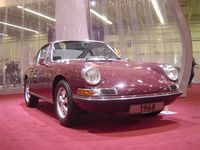Porsche 911 Named One of the Most Significant Autos of the 20th Century
• The Society of Automotive Engineers Honors the Rear-Engine Sports Car For its Engineering Excellence
• Originally designed by Ferdinand Alexander Porsche, grandson of company founder
ATLANTA - May 11, 2000: The Porsche 911, one of the world's most recognized sports cars and an automobile known for its performance prowess and rear-engine design, recently was cited as one of the most significant vehicles of the 20th century by readers of Automotive Engineering International, which is published by the Society of Automotive Engineers (SAE).
Readers were asked to vote on the car of their choice based on the following criteria: the car successfully introduced a new engineering system and/or solution that was adopted by others, the car enjoyed exceptional longevity in the marketplace, and the car achieved better performance than its contemporaries by virtue of excellence of its engineering. The 1964 Porsche 911 was voted the Best Engineered Car for the decade beginning in 1960.
The Porsche 911 was introduced in September 1963 at the International Auto Show in Frankfurt as a successor to the Porsche 356(TM) and became an instant hit. Originally designed by Ferdinand Alexander Porsche, son of Ferry Porsche, the car has been the platform for numerous automotive engineering developments during its 37-year history, including the following:
1964 The 911 showcases Porsche's new front suspension featuring
MacPherson struts, single lower transverse A-arms connected to
longitudinal torsion bars and rack-and-pinion steering, and a rear
system with transverse torsion bars and semi-trailing arms. Its new
air-cooled, horizontally opposed (boxer) six-cylinder engine
produces 148 horsepower at 6,100 rpm.
1965 A new open-air roof design - the Targa(R) top - is unveiled in 1965
for the 1967 911. The design features an easy-to-handle lift-off
section above the front seats, leaving a fixed rear "hoop" that
provides rollover protection and a large rear window.
1968 A new option, the Sportomatic four-speed automatic transmission, is
introduced specifically for the U.S. market.
1969 The 911 sports a longer 89.3-inch wheelbase (up from 87.04 inches),
wider rear fender wells to accommodate wider wheels and tires,
vented rotors and larger aluminum calipers.
1970 Engine displacement increases to 2.2 liters.
1972 Porsche introduces the 1973 2.7-liter Carrera(R) RS(R) with its
signature duck tail rear spoiler at the Paris Auto Show. The
Carrera RS is the first production Porsche with a rear spoiler. A
simple interior, lighter materials, gas shocks, super-stiff anti-
roll bars and 20 extra horsepower provides considerably improved
performance.
1976 The Porsche Turbo legend begins with the 911 Turbo Carrera,
initially called the 930(TM). The original model includes almost
every Porsche luxury and convenience item and produces 234
horsepower at 5,500 rpm.
1978 The 911SC is introduced with a 3.0-liter, 180-horsepower engine.
1983 A Cabriolet model, the first Porsche convertible since the 356, is
offered.
1989 An all-new platform is introduced for the 911 Carrera and the all-
wheel drive Carrera 4. The platform features a new front-suspension
design using light alloy cast control arms and coilover shock
absorbers, rear independent suspension with lower light alloy semi-
trailing arms and coilover shock absorbers, and all-wheel ABS.
Approximately 80 percent of the car is new.
1995 Another new platform, still retaining the original 911 lines, is
introduced. Carrera, Carrera 4 and Cabriolet models featuring
water-cooled heads and multi-link rear suspension are offered, and a
400-horsepower, twin-turbo 911 Turbo Carrera 4 is unveiled at the
1995 Geneva Auto Show.
1998 The latest 911 platform debuts in 1998 as a 1999 model year car.
The new 911 has the highly recognized 911 shape, but underneath is
all-new technology such as a 300-horsepower, water-cooled,
horizontally opposed six-cylinder engine, Tiptronic(R) S (automatic)
or manual transmission, all-wheel drive, and the Porsche Stability
Management system.
2000 An all-new, 415-horsepower 911 Turbo, based on this new platform, is
offered for the first time with the Tiptronic S transmission. It
also features twin turbochargers, the Porsche Stability Management
system, and all-wheel drive.
SAE is a non-profit educational and scientific organization dedicated to the advancement of mobility technology to better serve humanity. Nearly 80,000 engineers and scientists who are SAE members develop technical information on all forms of self-propelled vehicles including automobiles, trucks and buses, off-highway equipment, aircraft, aerospace vehicles, marine, rail and transit systems.
Porsche Cars North America (PCNA), based in Atlanta, Ga., is the exclusive importer of Porsche cars for the United States. A wholly owned subsidiary of Dr. Ing. h.c.F. Porsche AG, PCNA employs approximately 220 people who provide Porsche vehicles, parts, marketing and training for its 205 dealers in North America. They, in turn, provide Porsche owners with best-in-class service.



